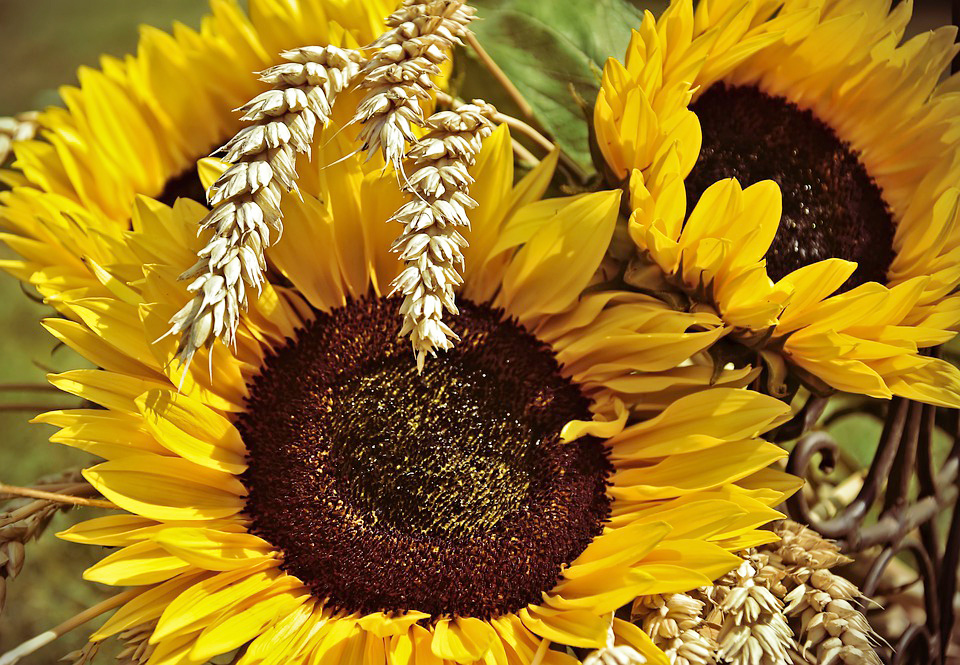Classification of sunflower seeds
There are two main classes into which crop seeds can be divided:
- for mass production of oils – contain about 50% fat and a high concentration of fatty acids;
- for the confectionery industry – grain is rich in protein and various acids.
It should be remembered that Shrovetide varieties are prone to cross-pollination. Therefore, to maintain proper product quality, you should carefully choose the planting location and neighbors.
Sunflowers are also classified according to their ripening time. The following varieties are distinguished:
- early ripening – growing season 70-90 days;
- mid-early – growing season 108-112 days;
- mid-season – growing season 110-116 days;
- medium late – growing season 116-120 days.
As a rule, the later a variety ripens, the higher the performance of its seeds. However, quality depends not so much on the variety, but on the conditions of sowing, growing and harvesting.Hybrid varieties deserve special attention. Created artificially, they have optimal yield indicators. Among the hybrids there are:
- classical hybrids are more resistant to classical pathogens;
- hybrids resistant to new types of pathogenic bacteria and pests;
- hybrids resistant to the herbicide Eurolighting;
- hybrids with a high oil content.
In addition, there are varieties that are more demanding in terms of soil conditions, watering and other care conditions, and those that do not require special attention. This is extremely important to consider when choosing seeds to grow.
Quality criteria for sunflower seeds
Among the main characteristics by which grain quality is determined are:
- color;
- taste;
- smell;
- clogging;
- fat content;
- humidity;
- infection.
These are the main criteria, without which the fruits of the crop will not even be sent to warehouses. Organoleptic properties, acid number, toxicity and radiological indicators are also often determined. In this case, the approximate norms of the main parameters according to GOST are as follows:
- humidity – 7%;
- trash – 1%;
- oil content – 3%.
There should be no grain infected with pests. This is a gross failure to comply with the rules of storage and harvesting. It also excludes toxic impurities as a violation of the safety of further use of the material.
It should also be taken into account that for different varieties of sunflower some properties are determined additionally. Thus, for confectionery seed varieties, the percentage of crude protein is very important. If oleic acid is produced from seeds, a specific analysis should be prescribed for the content of this element.
To achieve optimal quality indicators, it is necessary to perform a number of procedures during each agricultural operation. The first sorting of oilseeds is carried out after harvesting. This is followed by several more stages of cleaning sunflower seeds. During them, the grain is cleaned of debris and all kinds of mechanical impurities. And then a significant influence is assigned to proper storage and intermediate laboratory analysis.
Laboratory analysis of sunflower seeds
Laboratory analysis of grain includes technological operations using specific instruments and reagents. Before any operation, a thorough cleaning of the sunflower grain is carried out.
The leading place in the study is given to determining the oil content and moisture content of seeds. To analyze the first parameter, thoroughly cleaned and sorted seeds are ground in an oiled mortar. The raw materials are placed in special test tubes. Through the extraction process, crude fat is obtained from the seeds, which is dried for an hour at a temperature of 100-105 degrees. Oil content is determined by the formula:
X = (m – m1) * 100 / m2;
m is the weight of the flask with oil
m1 – weight of an empty flask
m2 – weight of a sample of seeds.
In addition to the extraction method, the refractometric method is used. While alcohol is used when placed in an extractor, a non-volatile solvent is used in a refractor. Refractometric analysis also makes it easier to determine seed moisture content. The accuracy of both methods is approximately the same.
It should be remembered that before carrying out any technological operation in the laboratory, the grain should be cleaned and sorted. The elimination includes:
- rotten and sprouted seeds;
- crops damaged by pests or diseases;
- husk;
- weed seeds;
- breasts of earth and sand particles.
At least 50 grams of the product are selected for quality testing. The analysis is carried out three times. Sometimes, when toxic particles are detected, the number of studies increases, and the batch may be subject to complete destruction.
For additional information and advice, please call: ☎ +38 (067) 822-85-58.






























